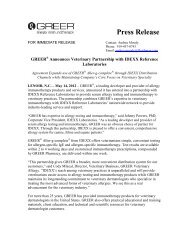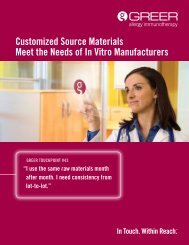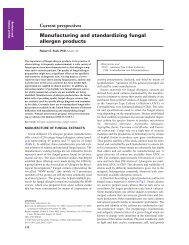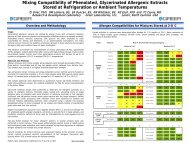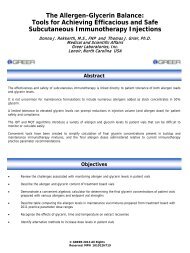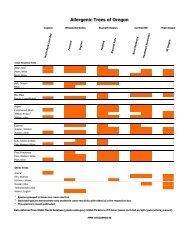Human Allergy Catalog - Greer
Human Allergy Catalog - Greer
Human Allergy Catalog - Greer
Create successful ePaper yourself
Turn your PDF publications into a flip-book with our unique Google optimized e-Paper software.
The initial dose of the extract may be as low as 0.1 mL of a 0.005 to 0.05BAU/mL dilution (0.0005 to 0.005 BAU) (dilution 5 or 6 in TABLE 4 below) oreven less for the exquisitely sensitive patient. Patients with lesser sensitivity maybe started at 0.1 mL of a 0.5 to 5 BAU/mL dilution (0.05 to 0.5 BAU).The amount of allergenic extract is increased at each injection by no more than50% of the previous amount, and the next increment is governed by the responseto the last injection. Large local reactions which persist for longer than 24 hoursare generally considered an indication for repeating the previous dose or reducingthe dose at the next administration. Any evidence of systemic reaction is anindication for a reduction of 75% in the subsequent dose. The upper limits ofdosage in BAU have not been established. Doses larger than 0.2 mL of an extractin 50% glycerin may cause discomfort upon injection. The dosages of allergenicextracts do not vary significantly with the allergic disease under treatment.To prepare dilutions starting from a 100,000 BAU/mL concentrate, proceed as inTABLE 4. The 50,000 BAU/mL concentrate can be made by using equal parts ofthe 100,000 BAU/mL extract and the sterile diluent. The ten-fold dilution seriesuses 0.5 mL of concentrate to 4.5 mL of sterile diluent with additionaldilutions made in the same manner.TABLE 4Ten-Fold Dilution Series*Dilution Extract Diluent BAU/mL BAU/mL0 Concentrate 100,000 10,0001 0.5 mL concentrate 4.5 mL 10,000 1,0002 0.5 mL dilution 1 4.5 mL 1,000 1003 0.5 mL dilution 2 4.5 mL 100 104 0.5 mL dilution 3 4.5 mL 10 15 0.5 mL dilution 4 4.5 mL 1 0.16 0.5 mL dilution 5 4.5 mL 0.1 0.01*Due to differences such as source material, preservative, potency dilutions,storage conditions, and length of storage, there is no common potency correlationratio between extracts standardized in Bioequivalent <strong>Allergy</strong> Units (BAU) and: 1)standardized extracts previously labeled in <strong>Allergy</strong> Units (AU); 2) nonstandardizedextracts labeled weight-to-volume (w/v); 3) nonstandardized extracts labeledin Protein Nitrogen Units (PNU); or 4) alum-precipitated extracts.The optimal interval between doses of allergenic extracts has not been established.Injections usually are given 1 or 2 times per week until the maintenance dose isreached. The injection interval is then increased to 2 weeks, then to 3 weeks andfinally to 4 weeks. If the patient does not return for 6 to 8 weeks, the dose shouldbe reduced to 25% of the last dose. If longer than 8 weeks, a dose reduction ofone, two or three dilutions may be made considering the components and thepatient’s sensitivity. The dosage and the interval between injections may need tobe modified according to the clinical response of the patient. When switchingpatients to fresh extract, the initial dose should be reduced to 25% of theprevious dose.13




